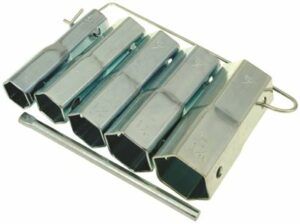A malfunctioning shower valve can quickly turn a relaxing shower into a frustrating experience. Fluctuating temperatures or the sudden loss of hot water can often be traced to an issue with the valve stem, the central component of your shower’s control system.
The good news is that repairing a faulty valve stem is a straightforward DIY project many homeowners can tackle. In this guide, This Old House plumbing expert Richard Trethewey provides a step-by-step walkthrough on identifying and resolving shower valve stem issues quickly.
Common Problems with Shower Valve Stems
Shower valve stems regulate the flow and temperature of the water. When these stems wear out or become damaged, they can cause various issues that disrupt your daily routine.
Below are some common issues that may occur with a faulty shower valve stem:
- Leaks around the handle or spout: Water seeping from the handle area or dripping from the spout often indicates worn-out washers or seals within the valve stem.
- Water dripping from the showerhead when turned off: A persistent drip after turning off the shower suggests a worn valve stem that doesn’t seal properly.
- Difficulty turning the handle: If the shower handle becomes stiff or challenging to turn, it is usually due to mineral buildup, corrosion, or a worn valve stem.
- Handles that are loose or difficult to turn: A loose or stiff handle can signal a worn or obstructed valve stem, making it harder to control water flow and temperature.
- Inconsistent water temperature: Fluctuating water temperature might result from the valve stem struggling to properly regulate the hot and cold water mix.
- Squealing or whistling noises when the shower is running: Unusual noises such as squealing or whistling could indicate a damaged or misaligned valve stem, often caused by wear or mineral deposits.
- Sudden loss of hot or cold water: A complete loss of hot or cold water is often due to a damaged or stuck valve stem affecting water flow.
Tools and Materials Needed
Before beginning the repair process, gather the following tools and materials:
 Pocket knife
Pocket knife Phillips screwdriver
Phillips screwdriver Shower valve socket wrench set
Shower valve socket wrench set Seat wrench
Seat wrench Pliers
Pliers
You’ll also need to buy a new valve stem and seat, available at most big-box hardware stores.
Steps to Repair a Shower Valve Stem
Follow our step-by-step guide below to repair your shower valve stem.
Step 1: Prepare for the Repair
Turn off the water supply for the shower by locating the main water shutoff valve in your home, then cover the drain with a cloth to prevent small parts from falling in.
Step 2: Remove the Old Valve Stem
Remove the screw holding the shower handle in place, then pull the handle free of the valve stem. By hand, unscrew and remove the escutcheon to expose the stem.
Use a valve socket and pliers to loosen and remove the old stem from the wall. Unthread the existing seat from inside the valve with a seat wrench.
Step 3: Install the New Valve Stem
Brush pipe-thread sealant onto the threaded end of the new stem seat. Use the seat wrench to tighten the new stem seat into the valve.
Carefully hand-tighten the new valve stem into the valve body, then tighten it with the valve socket and pliers. Repeat the previous steps to install new seats and stems onto the diverter and cold-water faucet handle.
Step 4: Reassemble the Shower Components
Apply plumber’s putty to the back of each escutcheon plate and hand-tighten them onto the stems. Reattach the shower handles to the valve stems, then snap the index covers back onto the handles.
Step 5: Test the Repair
Remove the cloth from the drain and turn the water supply back on.
Run the shower and check for leaks around the handle and spout. Test the water temperature to make sure it remains stable. Verify that the handle turns smoothly and controls the water flow properly.
If you encounter any issues during testing, double-check your work and verify all components are properly tightened.
Additional Tips for Successful Repairs
Before starting your shower valve repair, double-check that the new parts match your existing setup to avoid compatibility issues. Taking pictures of your valve setup before disassembling can be a helpful reference during reassembly to make sure everything goes back together correctly.
While working on the valve, keep a bucket or towel nearby to catch any water that may spill. If your shower has multiple valves, it’s wise to consider replacing all of them at once to maintain uniform performance and prevent future issues with other valves.
When To Call a Professional
While many homeowners can repair a shower valve stem on their own, there are certain situations where it’s best to call a professional. If you’re uncomfortable working with plumbing systems or lack the necessary tools and experience, a licensed plumber can guarantee the repair is done correctly and safely. Additionally, if you encounter unexpected complications during the repair process, such as persistent leaks or issues with water flow, a professional can provide the expertise needed to resolve these problems efficiently.
Older or more complex shower valve systems may require specialized knowledge and skills beyond typical DIY capabilities. A licensed plumber is better equipped to handle intricate valve mechanisms and ensure proper installation in these cases. If the problem persists despite your best efforts at repair, it’s wise to consult a professional to address any underlying issues and prevent further damage.
Preventative Maintenance for Shower Valves
Use these tips to keep your shower valves in working condition:
- Clean shower handles and stems regularly to prevent mineral buildup.
- Avoid using excessive force when turning shower handles.
- Periodically check for leaks or drips.
- Address minor issues promptly to prevent them from escalating.





